Star Names and Brightness
by Dr Jamie Love © 1997 - 2011
© 1997 - 2011
 © 1997 - 2011
© 1997 - 2011
There's no doubt about it. ORION (The Hunter) is the most striking constellation in the sky! It's bright and there is nothing in the sky you can mistake it with. There are several exciting astronomical sights in ORION and this constellation is an excellent "pointer" to many important parts of the sky.
ORION was called "The Hunter" by the Ancients because it looked to them like a man (named "Orion") out for a bit of hunting. Today's amateur astronomers don't have the imagination to see a hunter, but it's still an appropriate nickname for ORION because we use this constellation to hunt for a wide variety of astronomical objects.
Is ORION always in the same place?
No. As the hours go by ORION, like any "equatorial" constellation (explained below), will move across the sky from east to west. This is due to the Earth's daily rotation on its axis. (Which always points to Polaris. Remember?) Soon after a February sunset ORION will be found rising in the east and appearing to lie on his side, as if he was getting out of his bed on the eastern horizon. Around midnight in February ORION will be directly south and positioned upright. As the months progress ORION, like any equatorial constellation, will move eastward eventually catching up with the Sun and become lost in its glow. In the summer months ORION can only be seen as a morning constellation (if at all), so February evenings are the best time to learn how to find "him".
So, how do you find ORION?
ORION is kind of hourglass-shaped with two brilliant stars at opposite corners and a series of three dimmer stars in a line at the center. As you look at ORION try to picture a man ("Orion") facing you. On his right shoulder is the bright reddish star Betelgeuse and on his left knee is the brilliant blue-white star called Rigel. [We'll talk about star colors in next month's lesson. Here, in these images, I've added more color than is natural in order to emphasize them.]
|
The three stars in the center of the man form a "belt" across
his middle and they happen to be along (or at least near) the Celestial Equator. The Celestial Equator divides the night sky into two hemispheres - north and south. It's an imaginary line projected from the Earth's Equator into the sky.
Betelgeuse is in the Northern (Celestial) Hemisphere, only 7o above the Celestial Equator so we say it has a declination of +7o. Northern stars have a positive declination. Southern stars have a negative declination. Rigel is 8o south of the Celestial Equator, so astronomers say it has a declination of -8o. Declination is important to understand because it lets you figure out what stars can be seen from your location. | 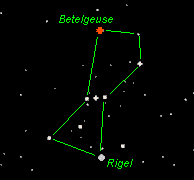
|
For example, from the North Pole you will only be able to see the northern half of ORION. Betelgeuse will be visible, 7o above the (southern) horizon, but not Rigel, because it will be below the horizon. From the South Pole only the southern half of ORION can be seen, so Rigel will be 8o above the (northern) horizon, but Betelgeuse will be below the horizon.
Recall that in your first lesson you used your latitude and Polaris to determine which stars would be circumpolar and which would not be circumpolar. That was a "backward" way of doing it but I taught it that way in order for you to understand how Polaris is the center of our celestial clock and the axis upon which the sky appears to rotate. Here you see that the correct way to determine a star's celestial "latitude" is by declination which is measured from the Celestial Equator NOT Polaris. The Celestial Equator is exactly 90o from Polaris. Therefore, circumpolar stars are those with a declination greater than the value you get by subtracting your latitude from 90o.
Huh?
Well, if your latitude is 35oN any star with a declination of more than +55o will be a circumpolar star. I figured that out by subtracting +35o (your latitude) from +90o (the declination of Polaris) to get +55o (the lowest possible declination of a circumpolar star as seen from a latitude of 35oN). Any star with a declination of less than +55o will eventually dip below the horizon.
Here's another example and another way to think about declination and circumpolar stars.
How far north must you be in order for Betelgeuse to be a circumpolar star?
You recall that Betelgeuse has a declination of +8o so it's only slightly above the Celestial Equator. That might give you a clue (or a confusion  ) that you must be pretty far north for Betelgeuse to never set. If you subtract Betelgeuse's declination (+8o) from Polaris's declination (+90o) you discover that from any latitude above 82oN Betelgeuse will never set. It will be circumpolar. On the other hand, if you live at a latitude below (south of) 82oN, then Betelgeuse will go though the daily behavior of rising and setting - like the Sun.
) that you must be pretty far north for Betelgeuse to never set. If you subtract Betelgeuse's declination (+8o) from Polaris's declination (+90o) you discover that from any latitude above 82oN Betelgeuse will never set. It will be circumpolar. On the other hand, if you live at a latitude below (south of) 82oN, then Betelgeuse will go though the daily behavior of rising and setting - like the Sun.
That "feels" wrong. Why must you be so far north to make such a southerly star circumpolar?
I understand your confusion and sympathise with it. I felt the same way when it was first taught to me.
Realise that a view of the night sky from the North Pole would have the entire Celestial Equator circling the entire horizon. (That would be the "southern" horizon in every direction!  ) None of those stars would set. They would be circumpolar because they all have a positive declination.
) None of those stars would set. They would be circumpolar because they all have a positive declination.
Now imagine you were to walk towards any horizon. (They are all southerly.) As you worked your way south, some of the stars along the opposite horizon, which is now your northern horizon, will dip below it, out of sight. The first ones to disappear will be the ones with just barely a positive declination. If you had walked directly away from Betelgeuse you would see it go below the horizon when you were 8o from the North Pole. That would be at a latitude of 82o.
Think about that a bit and try to figure out the declination of circumpolar stars for your latitude.

|
To the right of Betelgeuse is a dim star, kind
of in ORION's throat. Some textbooks don't draw a "connecting
line" to this star because it's so dim. There are no rules about the imaginary lines you draw to make your constellation, but if you connect the brightest stars
in ORION you get a nice hourglass shape that can be imagined
as a man.
In this image he is a bit tilted but remember that the constellations revolve around Polaris so ORION may actually be at many different angles. Learn to recognize him in various positions. Fortunately, unlike the Dippers we learned about last month, ORION is an "equatorial" constellation so his tilt changes only slightly. |
What do you mean by "equatorial"?
"Equatorial" means near the Equator and in the case of ORION we have a constellation that is right on the Equator.
Unless you are at the pole(s) an equatorial star is never circumpolar. It will rise and set. An equatorial constellation will change its angle as it passes through the night sky but it will never turn completely upside down like a circumpolar constellation can. Recall that, for most people, CASSIOPEIA can be an "M", "W" or anything in between because, for most people, CASSIOPEIA is a circumpolar constellation.
"Equatorial" isn't as specific a definition as circumpolar and you will hear the word "equatorial" used to refer to anything that is in line with or near the Equator. The paths of the planets, the Moon, the Sun, and some constellations (and some man-made satellites) are often described as equatorial. That means they are near the Celestial Equator. Most objects in our Solar System are found near the Celestial Equator so equatorial objects attract a lot of attention in astronomy. Indeed, some telescopes are built in such a way as to allow equatorial objects to be followed easily and those kinds of telescopes are said to have an "equatorial mounting"
But this is getting a little off topic. The important point about equatorial objects is their nightly behaviour. ORION and all its stars are equatorial so they rise and set.
Do the other stars in ORION have names, besides Betelgeuse and Rigel?
Yes, all the visible stars have names or letters to identify them. The really obvious stars have both! Star names are based on two systems. The first system uses the Ancient name of each star. This is a fun way to remember the stars because it maintains a tradition and links us to our past. However it can be a bit overwhelming, because many of these names are from languages no longer spoken - at least not by most astronomers! In 1603 a German astronomer named Johann Bayer made a star catalogue in which he named each star using the Greek alphabet to designate the star's relative brightness in that constellation.
For example, Betelgeuse is sometimes (but not always, see below) the brightest star in ORION, so it is called alpha-ORION
because alpha is the first letter of the Greek alphabet. This
is often written as  ORI,
the symbol is alpha and ORI is the three letter abbreviation for
ORION. ORI,
the symbol is alpha and ORI is the three letter abbreviation for
ORION.
Rigel is the second brightest star in ORION so it
can be called beta-ORION (
The third brightest star in ORION is the one that makes up his
left shoulder. If I didn't know it's Ancient name (Bellatrix),
any astronomer in the world would know which star I am talking
about because I would call that star gamma-ORION ( | 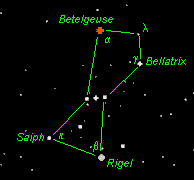
|
If you take your astronomy seriously, it helps to learn the Greek alphabet as well as the names of the obvious stars. However, sometimes it isn't easy to determine which star is the brighter of the pair. Making matters even more complicated, some stars actually change their brightness! Betelgeuse is such a "variable star" and (I assume) it was brighter than Rigel the day that Bayer named the stars in ORION. We will come back to the topic of variable stars throughout these lessons when I will explain the different ways these variations occur. For now, please accept that some stars vary in brightness.
Fortunately
textbooks and star maps help you correctly name the stars. If you want to know
the name of the star in ORION's right knee a look at a star map
will tell you it's kappa-ORION ( ORI)
and goes by the Ancient name of Saiph. I don't know the
name of the star in ORION's "throat" but I can see from
this map that it is lambda-ORION (
ORI)
and goes by the Ancient name of Saiph. I don't know the
name of the star in ORION's "throat" but I can see from
this map that it is lambda-ORION ( ORI).
ORI).
Bayer's system would be better if astronomers had strictly used it, but they didn't. Some stars were assigned a Greek letter as if the fellow who named them was half blind!  Generally speaking you can use Bayer's system to get a rough idea of the brightness of each star in a constellation but it shouldn't be taken as an absolute law. When in doubt, check the star maps for the proper name.
Generally speaking you can use Bayer's system to get a rough idea of the brightness of each star in a constellation but it shouldn't be taken as an absolute law. When in doubt, check the star maps for the proper name.
Also, you should know that there are other star-naming methods based on different systems. One method numbered all the stars and uses the prefix "HIP". A similar method uses the prefix "HR" followed by a dull, number designation. These alternative methods pop up every now and then so you might see them but I won't use them in our lessons because they are confusing, dull and don't even provide you with information that might let you make an intelligent guess about the star's brightness.
Why are some stars brighter than others?
The brightness of a star in our sky, its relative magnitude, depends upon its distance from us AND the "true brightness" of the star. This "true brightness" is called the star's absolute magnitude. Imagine two stars of the same absolute magnitude (same true brightness) but one star is closer to us than the other. The closer star will appear brighter to us here on Earth so it will have a lower relative magnitude.
Notice that the magnitude scale runs in reverse - brighter stars have lower magnitudes! I was taught to remember this by thinking about golf scores - the most brilliant golfers have the lowest scores.
Stars are all very, very far away. Astronomers don't measure the distances to stars in miles or even kilometers because the numbers would be huge. Instead they use "light-years". One light-year is the distance that light travels in a year.
Light travels very fast through space - almost 300,000 kilometers in a second!
What's that in "miles per hour"?
I don't know and no astronomer worth his lens would use miles per hour (unless talking to the media). Using old-fashion measurements, light travels at 186,282 miles a second. You can do the maths. (I won't!) I think it's better to work in kilometers per second. Don't you?
Yeah, I suppose.
Good.
It takes a little over eight minutes for the light of the
Sun to reach us and the Sun is only 150 million
kilometers away. That brings us to the other useful astronomical
unit of measurement. Indeed, it is called an "Astronomical
Unit" or AU. One AU is the distance from the Earth
to the Sun. Unfortunately, the Earth's orbit, like most
orbits, is not a perfect circle so that measurement varies slightly,
but one AU is around 150 million kilometers.
[We will discuss the shape of orbits in June. Gee there's so much to learn!  ]
]
AU's and light-years are the two fundamental units of distance in astronomy and you should try to become comfortable with them. When astronomers speak of distances and movements of planets or comets they usually use AUs because it's a convenient "yard stick" for things moving around our Solar System. When astronomers speak of stars or galaxies they are usually described at distances measured in light-years.
So how far in a light-year!?
In one year a beam of light can travel over nine trillion kilometers. (That's 9,000,000,000,000 kilometers.) You have to travel over 4 light-years, about 37 trillion kilometers, to reach the next star! Another way to think about that is it takes over 4 years for the light from the next star to reach us. And nothing travels faster than light!
Wow, space is a big place.
Yes, it is. It takes very careful observations and measurements to prove their actual distances. (In November I'll tell you how astronomers measure distances and that is when I will teach you about another unit of measurement used in astronomy called the parsec.) Although these distances are huge, they are also helpful because we can get away with imagining that the stars are on a fixed sphere very far away. All the constellations are imagined as stars fixed on a sphere even though that's not true. A constellation may have lines drawn through it connecting stars that are actually very far apart. Sometimes stars may look like they are right next to each other, and I might even describe them that way, when in fact they could be many light-years apart. (When they are actually close together I will tell you so.)
Our lessons are primarily "observational astronomy"
of objects seen from Earth so we will be dealing mostly with relative magnitude. However, you should be aware that
when astronomers describe a star as being (for example) "a
thousand times brighter than our Sun", they are talking about
that star's absolute magnitude.
Speaking of the Sun, it
too is a star - just a normal star of normal brightness - but it's
so close to us that its relative magnitude is a HUGE NEGATIVE
number! (Minus 26.8 to be exact.) Our Sun is the only star that you should not stare
at because it is so near us that it is extremely brilliant. Staring
at the Sun for just a second or two will burn a spot, perhaps
permanently, into your eyes!
How is magnitude measured?
Astronomers use a photoelectric cell to measure how much a star shines. This is a measure of its relative brightness and this figure is adjusted to a figure called "magnitude". Each unit of magnitude corresponds to a difference in brightness of 2.52. (Don't ask why!) As if that weren't confusing enough, the magnitude scale runs in reverse (remember), so stars with bigger (positive) magnitudes are dimmer than those with smaller magnitudes. (I know I'm repeating myself, but it bares repeating.)
It isn't important to understand the details of how, or the reason why, magnitudes are calculated but you should know that dimmer objects have larger magnitudes than brighter ones even though that may seem backward.
Well, what star has the lowest relative magnitude? What's the brightest star in the sky?
The Sun! (Gotcha!) 
OK, (wise guy) what star in the NIGHT sky has the lowest relative magnitude?
That would be Sirius. This is an easy star to find, especially now that you know ORION.
|
Imagine a line through ORION's belt going
from right to left (ORION's left to right). Now extend that line
to the left (ORION's right) about 20 degrees. That's about "one
handful of sky" if you recall your lessons from last month. Sirius
is the very bright star. You can't miss it!
Sirius is in a constellation
called CANIS MAJOR (The Big Dog). The Ancients thought it looked like a dog. (The
Ancients were very imaginative.)
Astronomers have figured out that Sirius has an absolute magnitude 25 times brighter than our Sun but, because Sirius is so distant (8.6 light-years, or about 77 million million kilometers), it has a relative magnitude much higher - meaning it is much dimmer. | 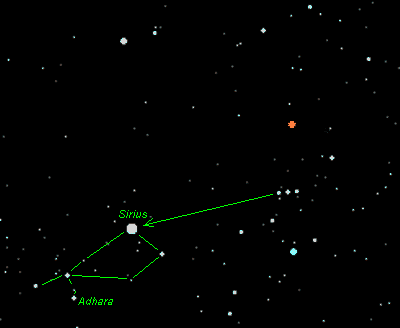
|
Yet, Sirius is still pretty bright. It has a relative magnitude of -1.4. (That's "MINUS one point four".). Stare at Sirius as much as you like. It won't hurt you.
Sirius is obvious, even dazzling, in the night sky and has attracted the attention of man for millennia. The Ancient Egyptians, thousands of years ago, noticed that the annual flooding of the Nile each spring coincided with the arrival of Sirius as a "morning star". (Note that here in our lesson Sirius is an evening star because we are studying it in February.) The flooding of the Nile was an important event for farmers in the region and the Ancient Egyptians computed a very accurate calendar based upon the arrival of Sirius in their morning sky. Their "Sirius calendar" had 365 1/4 days in a year (the correct number) even though they used a "civilian calendar" of 365 days per year. Egyptologists tell us that the Ancient Egyptians may have worshipped this star and arranged some of their tombs (pyramid chambers) to line up with Sirius during important ceremonies.
Adhara is the second brightest star in CANIS MAJOR (magnitude of 1.5) so you might expect Bayer to have named it "beta CANIS MAJOR", but no. Bayer designated this star "epsilon CANIS MAJOR", the fifth letter of Greek alphabet! Perhaps Bayer was experiencing some cloud cover that night. Maybe he did these things to make astronomy more difficult!  Regardless, be aware that there are exceptions to many of the "Bayer names". Check the star maps because they are the authority.
Regardless, be aware that there are exceptions to many of the "Bayer names". Check the star maps because they are the authority.
|
What's that other bright star to the left and slightly above
ORION?
That would be Procyon. It can be found by imagining a line from Bellatrix to Betelgeuse and extending it a bit further than the distance to Sirius. Procyon is the brightest star in the constellation of CANIS MINOR, The Little Dog, a very boring constellation. This star has a (relative) magnitude of 0.4. Notice that Procyon is dimmer than Sirius so it has a larger value for the magnitude. (Don't let Sirius' negative value fool you. Just think of it as a number line, including negative values for Sirius, and you'll see what I mean.) | 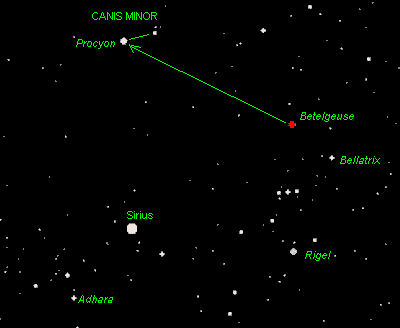
|
Try to get used to the idea of differences in magnitude. Rigel has a magnitude of about 0.2, so it is slightly brighter than Procyon. Betelgeuse (currently) has an average magnitude of about 1.
It's confusing!
Yes, but don't let that worry you. It's difficult to actually see these differences in a quantitative
sense, so many astronomers like to refer to stars in groups of
magnitude. For example, Betelgeuse, Rigel and Procyon
are often described as "first magnitude stars". Bellatrix
is a second magnitude star meaning it has a magnitude between
1.0 and 2.0 so it will be dimmer than Betelgeuse. Saiph
is a third magnitude star so its magnitude is between 2.0 and
3.0 therefore it will be dimmer than Bellatrix. All
amateur astronomers should learn at least a few star magnitudes
so they can be used for comparison.
Like Bayer's Greek alphabet system, the magnitude groups are not written in stone and there are exceptions. Think of these groups as a rough guide.
What's the best way to learn star magnitudes?
A great way to learn magnitudes is to watch a familiar constellation as the twilight sky turns darker.
|
On a clear evening the stars will appear at dusk according
to their magnitude.
In February, soon after the Sun sets in the
western sky, you will first see Sirius appear in the eastern
sky.
On a perfectly clear, dark, moonless night you can see stars as
dim as sixth magnitude.
| 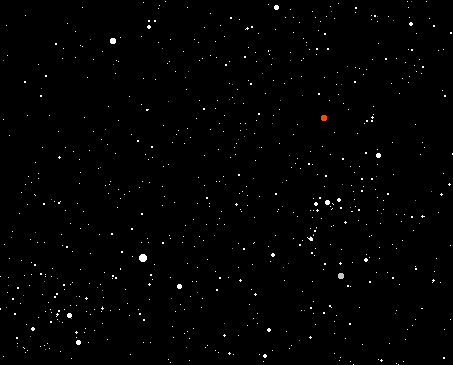
|
Regardless, you should be able to pick out all the stars and constellations from this month's lesson in this image. Go back (up) to the previous image and compare. Adjust the brightness on your computer's monitor in order to simulate dusk.
Are there other constellations on which I can practise my magnitudes?
Yes, a great place to practise your magnitudes is among the two
Dippers.
Most of the stars of the Big Dipper are of second magnitude
and so is Polaris, which has a magnitude of 2.1 (so it's
pretty bright for a second magnitude star).
Best of all, the four
stars that make up the bowl of the Little Dipper each have a different
magnitude. I'll leave you to figure out which one is 2nd, 3rd,
4th and 5th magnitude, but I'll get you started.
|
First find Polaris.
Now look for a star in the Little Dipper's bowl that is nearly
as bright as Polaris. That's the second magnitude star
of the bowl. Now figure out which of the three remaining stars
is next in brightness. That's the third magnitude star of the
Little Dipper's bowl. Continue this until you've assigned a different magnitude to each
star in the Little Dipper's Bowl. Note that its dimmest star is only of fifth magnitude so
it may be difficult to see unless the night is very clear and
dark.
It will also be difficult to see in this image unless you have the brightness of your computer's monitor set high, so fiddle with your brightness settings in order to watch the Little Dipper's stars "come out". | 
|
This image of the Dippers, showing all stars down to a magnitude of five, is a very good image to learn in the night sky. The Little Dipper is always visible in a clear northern sky so it can be a useful "magnitude checker".
The two Dogs follow the Hunter through the night sky and they
are wonderful constellations to view and learn about. Go outside
some clear evening this month and find these constellations and
identify the stars I've mentioned. Notice the differences in magnitude.
Remind yourself that ORION's belt is on the Celestial Equator and imagine how his position in the sky would change if you were further north or south. If you were to walk towards the South Pole, at what latitude would Betelgeuse become impossible to see? At what latitude would Rigel disappear?
Extend your hand and work out how many fingers it takes to cover the sky from ORION's belt to Rigel or Betelgeuse.
Before going to bed have a look at these constellations from a south facing window and notice how they have moved in the few hours since you last looked at them.
Work out the most southerly declination of a circumpolar star for your latitude. If you are in the southern hemisphere all the maths would be the other way around. Ask yourself how you would figure out the most northerly declination of south circumpolar stars!
Next month we will return to ORION to help us identify some other important stars and constellations. We'll also learn about star colors. So bundle up, go outsided and learn this month's lesson.








